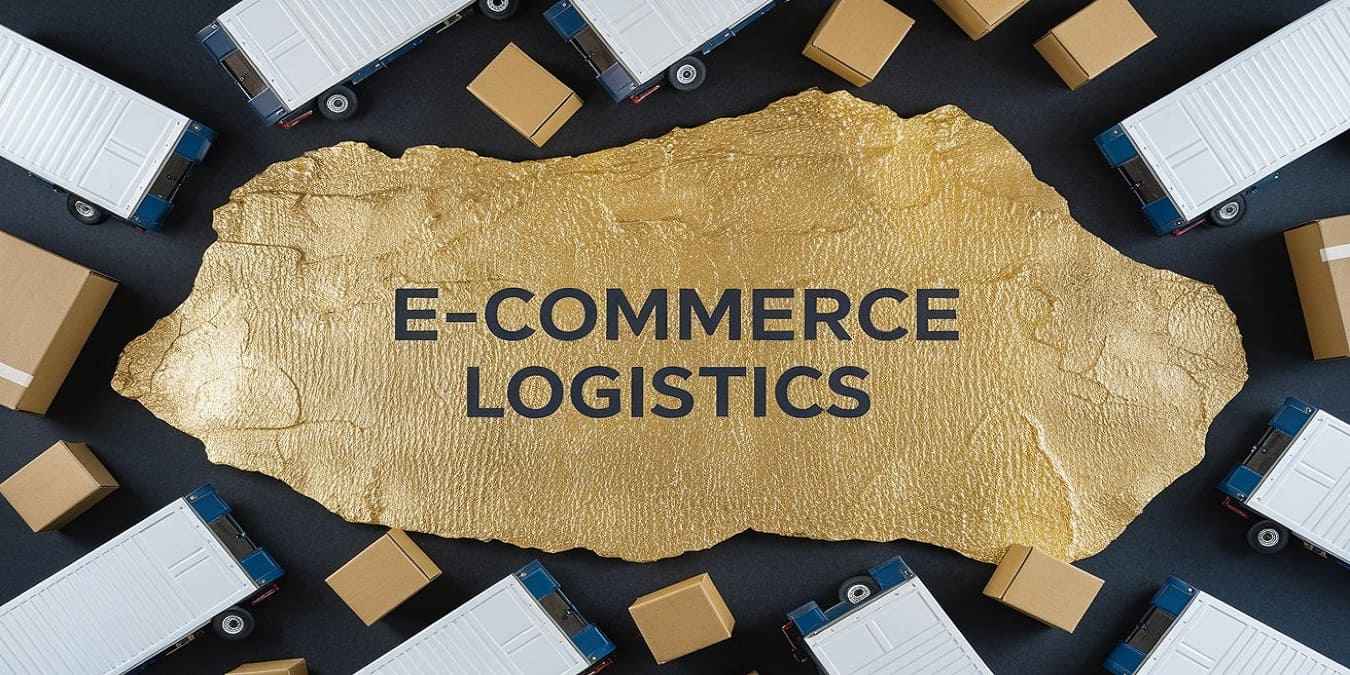
Introduction: Beyond the Buzz of AI and Tech
In today’s fast-paced world, it seems like every conversation revolves around artificial intelligence (AI), blockchain or the latest tech unicorn. These industries dominate headlines, attract billions in venture capital and are often touted as the future of business. But what if I told you that while everyone is fixated on these flashy sectors, another industry is quietly raking in billions, without nearly as much fanfare?
This overlooked sector isn’t just surviving; it’s thriving. It’s solving critical problems, meeting growing demands and positioning itself as a cornerstone of the U.S. economy. If you’re an entrepreneur looking for your next big opportunity or simply curious about where the market is headed, you won’t want to miss this untapped goldmine.
So, which industry am I talking about? Let me introduce you to E-Commerce Logistics , a field that has been steadily transforming behind the scenes and is now poised to dominate the U.S. market in ways few could have predicted.
Why E-Commerce Logistics Deserves Your Attention
Before we dive deeper, let’s clarify what e-commerce logistics entails. At its core, e-commerce logistics refers to the processes involved in managing the movement of goods from manufacturers to consumers through online platforms. This includes warehousing, inventory management order fulfillment, shipping, returns processing and last-mile delivery, the final step of getting products into customers’ hands.
While many people associate e-commerce with giants like Amazon, Shopify or Etsy, they often overlook the intricate web of services required to make those seamless shopping experiences possible. And here’s the kicker: as consumer behavior shifts increasingly toward online shopping, the demand for efficient, reliable and innovative logistics solutions is skyrocketing.
The Numbers Don’t Lie
Consider these eye-opening statistics:
- According to Statista, U.S. e-commerce sales are projected to reach $1.34 trillion in 2025, accounting for nearly 17% of total retail sales.
- A report by McKinsey & Company highlights that 60% of consumers now expect same-day or next-day delivery, a trend driving unprecedented pressure on supply chains.
- The global e-commerce logistics market is likely to be over $848 billion in 2025 and is expected to grow at a compound annual growth rate (CAGR) of 14.8% over the next five years.
These figures underscore not only the scale of the opportunity but also the urgency for businesses to adapt to changing expectations. For entrepreneurs willing to explore this space, the potential rewards are immense.
What Makes E-Commerce Logistics So Promising?
To understand why e-commerce logistics is such a lucrative industry, we need to examine the key factors fueling its growth. From shifting consumer habits to technological advancements, several trends are converging to create a perfect storm of opportunity.
- The Rise of Online Shopping
The pandemic accelerated the adoption of online shopping and even as life returns to normal, consumers aren’t turning back. Convenience, variety and competitive pricing have made e-commerce a staple of modern life. However, this surge in online orders places immense strain on traditional supply chain models. Companies must rethink how they store, pick, pack and ship items to meet rising demand efficiently.
- The Last-Mile Delivery Challenge
Last-mile delivery, the process of transporting packages from a distribution center to the end customer, is notoriously complex and costly. Yet, it’s also the most critical touchpoint in the customer journey. Consumers value speed and reliability above all else, making last-mile optimization a top priority for retailers. Innovations in route planning software, autonomous vehicles and drone deliveries are revolutionizing this segment, creating new niches for startups to thrive.
- Sustainability Concerns
As environmental awareness grows, so does the demand for eco-friendly logistics solutions. Shoppers are increasingly favoring brands that prioritize sustainability, whether through reduced packaging waste, carbon-neutral shipping options or ethical sourcing practices. Forward-thinking companies are capitalizing on this trend by offering green logistics services, further differentiating themselves in a crowded marketplace.
- Technological Advancements
Technology is reshaping e-commerce logistics in profound ways. Automation, artificial intelligence and data analytics are streamlining operations, reducing costs and improving accuracy. For example:
- Warehouse Robotics: Automated systems can handle repetitive tasks like sorting and packing faster than humans, freeing up workers for more strategic roles.
- Predictive Analytics: Advanced algorithms analyze historical data to forecast demand, optimize inventory levels and prevent stockouts.
- Real-Time Tracking: GPS-enabled tools allow businesses and customers to monitor shipments in real time, enhancing transparency and trust.
These innovations lower barriers to entry for smaller players while enabling larger enterprises to scale their operations effectively.
Success Stories: Who’s Winning in E-Commerce Logistics?
To truly appreciate the potential of this industry, let’s look at some success stories from companies already making waves in e-commerce logistics.
Case Study #1: Flexport
Flexport, a San Francisco-based freight forwarding company, disrupted the traditional logistics model by introducing a digital platform that connects shippers, carriers and customs brokers. Their user-friendly interface provides end-to-end visibility into the supply chain, empowering businesses to manage international trade effortlessly. Since its founding in 2013, Flexport has raised over $2.5 billion in funding and achieved unicorn status, proving that there’s money to be made in simplifying complex logistics processes.
Case Study #2: ShipBob
ShipBob offers outsourced fulfillment services tailored specifically for small and medium-sized e-commerce businesses. By operating a network of strategically located warehouses across the U.S., ShipBob enables merchants to offer affordable two-day shipping without needing their own infrastructure. In 2024, the company processed millions of orders, demonstrating the scalability and profitability of third-party logistics providers.
Case Study #3: Rivian
While primarily known as an electric vehicle manufacturer, Rivian is branching out into sustainable logistics with its partnership with Amazon. The company’s electric delivery vans aim to reduce emissions associated with last-mile transportation, aligning perfectly with the growing emphasis on eco-consciousness. As more cities implement regulations to curb pollution, Rivian’s approach could set a new standard for urban deliveries.
These examples demonstrate the wide range of opportunities available in e-commerce logistics, spanning from software development to physical infrastructure and emphasize the critical role of innovation in maintaining a competitive edge.
How You Can Tap Into This Growing Market
If you’re intrigued by the prospects of e-commerce logistics, you might be wondering how to get started. Fortunately, there are numerous avenues to explore, depending on your skills, resources and risk tolerance.
- Start Small with Niche Services
Instead of trying to compete with established players like FedEx or UPS, consider carving out a niche.
- Focus on serving specific industries, such as perishable goods or luxury items.
- Offer specialized solutions, such as temperature-controlled storage or white-glove delivery.
By targeting underserved segments, you can build a loyal customer base and establish yourself as an expert in your chosen area.
- Leverage Technology
Tech-driven startups have a unique advantage in this space. Whether you’re developing warehouse automation software, designing smart packaging solutions or creating AI-powered routing apps, technology can help you stand out. Partnering with existing logistics firms to integrate your product into their workflows is another viable strategy.
- Invest in Green Initiatives
Sustainability isn’t just a buzzword, it’s a business imperative. Consider launching a service that helps companies reduce their carbon footprint, such as reusable packaging programs or shared truckload shipping. Not only will this appeal to environmentally conscious consumers, but it may also qualify you for government incentives or grants.
- Collaborate with Local Businesses
Many small businesses struggle with the complexities of e-commerce logistics. By offering affordable, localized services, such as pop-up fulfillment centers or community-based delivery networks, you can fill a crucial gap in the market while fostering strong relationships with local entrepreneurs.
Challenges to Watch Out For
Of course, no industry is without its challenges and e-commerce logistics is no exception. Here are a few hurdles you should be prepared to navigate:
- High Initial Costs
Setting up warehouses, purchasing equipment or developing proprietary software requires significant upfront investment. While these expenses can pay off in the long run, securing funding may pose a challenge for early-stage ventures.
- Regulatory Hurdles
Logistics involves navigating a maze of regulations, particularly when dealing with cross-border shipments. Staying compliant with customs laws, labor standards and environmental policies can be daunting, especially for newcomers.
- Intense Competition
Although e-commerce logistics is still relatively underexplored compared to other sectors, competition is heating up. Established players like DHL and XPO Logistics are investing heavily in innovation, while startups are emerging daily. Differentiation will be key to standing out.
Despite these obstacles, the rewards far outweigh the risks for those who approach the industry strategically and creatively.
Conclusion: Seize the Opportunity Before It Passes
E-commerce logistics represents one of the most exciting and underappreciated, opportunities in the U.S. market today. With e-commerce sales continuing to soar, the need for robust, efficient and sustainable logistics solutions has never been greater. Entrepreneurs who recognize this trend and act quickly stand to reap substantial benefits.
Whether you’re developing cutting-edge technology, providing specialized services or championing sustainability, there’s room for innovation in every corner of this dynamic industry. So, don’t let the hype around AI and tech distract you from the quieter revolution happening right under our noses. Dive into e-commerce logistics and discover how you can turn this untapped goldmine into your next big success story.
Are you ready to seize the moment? Share your thoughts in the comments below or visit https://usa-biz-growth.com for more insights on unlocking business growth opportunities!
Frequently Asked Questions (FAQs): The Untapped Goldmine of E-Commerce Logistics
To help you better understand the immense potential of e-commerce logistics and how you can leverage it for business growth, we’ve compiled a list of frequently asked questions. Whether you’re an entrepreneur exploring new opportunities or simply curious about this booming industry, these answers will provide clarity and actionable insights.
- What Exactly Is E-Commerce Logistics?
Q: I’ve heard the term “e-commerce logistics,” but what does it actually mean?
A: E-commerce logistics refers to the end-to-end process of managing the movement of goods purchased online. It includes warehousing, inventory management, order fulfillment, shipping, returns processing and last-mile delivery. Essentially, it’s everything that happens behind the scenes to ensure your online orders arrive on time and in perfect condition.
- Why Is E-Commerce Logistics Considered an “Untapped Goldmine”?
Q: Why is this industry considered so lucrative compared to others?
A: While industries like AI and tech grab headlines, e-commerce logistics operates quietly yet plays a critical role in enabling online shopping. With U.S. e-commerce reach $1.34 trillion in 2025, accounting for nearly 17% of total retail sales, the demand for efficient logistics solutions is skyrocketing. However, many entrepreneurs overlook this sector because it’s not as flashy as other fields. This creates a unique opportunity for innovators to step in and meet unmet needs, making it a true goldmine.
- How Big Is the Market for E-Commerce Logistics?
Q: Can you share some numbers to show how large this market really is?
A: Absolutely! The global e-commerce logistics market is likely to be over $848 billion in 2025 and is expected to grow at a compound annual growth rate (CAGR) of 14.8% over the next five years. In the U.S., e-commerce sales alone are projected to account for nearly 17% of total retail sales in 2025. These figures highlight the massive scale and untapped potential of this industry.
- What Are the Key Trends Driving Growth in E-Commerce Logistics?
Q: What trends should I pay attention to if I want to succeed in this space?
A: Several key trends are shaping the future of e-commerce logistics:
- Rising Consumer Expectations: Shoppers now expect same-day or next-day delivery, pushing companies to optimize their supply chains.
- Sustainability Demands: Eco-friendly packaging, carbon-neutral shipping and reduced waste are becoming priorities for both consumers and regulators.
- Technological Advancements: Automation, AI, robotics and real-time tracking systems are transforming traditional logistics processes.
- Urbanization and Last-Mile Delivery Challenges: As more people move to cities, delivering packages efficiently in densely populated areas has become a focal point.
- Who Are the Major Players in E-Commerce Logistics?
Q: Are there already big players dominating this industry?
A: Yes, established giants like Amazon, FedEx and UPS dominate parts of the market. However, innovative startups like Flexport (digital freight forwarding), ShipBob (third-party fulfillment) and Rivian (electric delivery vehicles) are carving out niches and challenging incumbents. There’s still plenty of room for smaller businesses to innovate and thrive, especially in specialized segments.
- What Are Some Low-Cost Ways to Enter the E-Commerce Logistics Industry?
Q: I’m interested in getting started, but I don’t have a lot of capital. Are there low-cost entry points?
A: Absolutely! You don’t need millions to break into e-commerce logistics. Here are some cost-effective ways to get started:
- Niche Services: Focus on a specific segment of the market, such as eco-friendly packaging, returns management or localized delivery services for small businesses.
- Partnerships: Collaborate with existing logistics providers to offer complementary services. For example, you could partner with a warehouse to provide tech-driven inventory management solutions.
- Freelance Consulting: If you have expertise in supply chain optimization or logistics software, consider offering consulting services to small and medium-sized businesses.
- Crowdsourced Delivery: Platforms like Uber Freight or Roadie allow individuals or small teams to participate in last-mile delivery without owning a fleet of vehicles.
- Tech Solutions: Develop lightweight software tools, such as route optimization apps or tracking dashboards, that solve specific pain points for logistics companies.
By starting small and scaling strategically, you can build a profitable business without breaking the bank.
- How Can Technology Help Me Succeed in E-Commerce Logistics?
Q: I’ve heard technology is a game-changer in this industry. How can I leverage it effectively?
A: Technology is transforming e-commerce logistics in profound ways. Here’s how you can use it to your advantage.
- Automation: Invest in warehouse robotics or automated picking systems to reduce labor costs and improve efficiency.
- Data Analytics: Use predictive analytics to forecast demand, optimize inventory levels and prevent stockouts or overstocking.
- Real-Time Tracking: Implement GPS-enabled tracking systems to give customers visibility into their shipments, enhancing trust and satisfaction.
- AI and Machine Learning: Leverage AI to streamline route planning, identify inefficiencies and personalize delivery options for customers.
- Blockchain: Explore blockchain technology for secure and transparent supply chain management, especially for cross-border shipments.
Even if you’re not a tech expert, partnering with developers or using off-the-shelf solutions can help you harness these innovations.
- What Challenges Should I Be Prepared to Face?
Q: What are the biggest obstacles in e-commerce logistics and how can I overcome them?
A: While the opportunities are vast, there are challenges to navigate.
- High Initial Costs: Setting up warehouses, purchasing equipment or developing software requires upfront investment. To mitigate this, start small, seek investors or explore crowdfunding platforms.
- Regulatory Hurdles: Navigating customs laws, labor regulations and environmental policies can be complex, especially for international shipments. Consider hiring legal experts or consultants familiar with logistics compliance.
- Intense Competition: The market is becoming increasingly crowded. Differentiate yourself by focusing on niche services, sustainability or superior customer experience.
- Supply Chain Disruptions: Events like natural disasters or geopolitical tensions can disrupt operations. Build resilience by diversifying suppliers and maintaining buffer inventory.
By anticipating these challenges and planning accordingly, you’ll be better equipped to succeed.
- Is Sustainability Really That Important in E-Commerce Logistics?
Q: Everyone talks about sustainability, but does it really matter in this industry?
A: Yes, sustainability is no longer optional, it’s essential. Consumers are increasingly prioritizing eco-conscious brands and governments are introducing stricter environmental regulations. Companies that fail to adopt sustainable practices risk losing market share and facing penalties. Here’s why sustainability matters.
- Consumer Demand: Studies show that 60% of shoppers prefer brands that prioritize sustainability. Offering green logistics solutions can attract loyal customers.
- Cost Savings: Sustainable practices like optimized routing and reusable packaging can reduce operational costs.
- Brand Reputation: Being eco-friendly enhances your brand image and sets you apart from competitors.
To stay ahead, consider implementing initiatives like carbon-neutral shipping, biodegradable packaging or electric vehicle fleets.
- How Can I Stay Ahead of the Competition in This Fast-Growing Industry?
Q: With so many players entering the market, how can I ensure my business stands out?
A: Standing out in e-commerce logistics requires a combination of innovation, customer focus and strategic partnerships.
- Specialize: Focus on a niche area where you can excel, such as luxury goods delivery, perishable item handling or rural logistics.
- Prioritize Customer Experience: Offer fast, reliable and transparent services. Happy customers are more likely to recommend you to others.
- Invest in Innovation: Stay ahead of technological trends and continuously improve your processes. For example, adopt AI-powered tools or experiment with drone deliveries.
- Build Strong Partnerships: Collaborate with complementary businesses, such as e-commerce platforms, manufacturers or tech startups, to expand your reach.
- Monitor Market Trends: Keep an eye on emerging consumer behaviors and industry shifts to adapt quickly and seize new opportunities.
By staying agile and customer-centric, you can carve out a competitive edge in this dynamic field.
- What Skills Do I Need to Succeed in E-Commerce Logistics?
Q: What skills or qualifications are most valuable for someone entering this industry?
A: Success in e-commerce logistics requires a mix of technical, analytical and interpersonal skills. Key areas to focus on include.
- Supply Chain Management: Understanding how goods move from point A to point B is foundational. Consider taking courses or certifications in logistics and supply chain management.
- Data Analysis: Proficiency in data analytics tools (e.g., Excel, Tableau or Python) will help you make informed decisions based on real-time insights.
- Problem-Solving: Logistics involves constant troubleshooting, so strong critical thinking and adaptability are crucial.
- Customer Service: Building relationships with clients and ensuring their satisfaction is key to long-term success.
- Tech Savviness: Familiarity with logistics software, automation tools and emerging technologies will set you apart.
If you’re lacking in any of these areas, don’t worry, there are plenty of online resources and training programs to help you upskill.
- Where Can I Find More Resources About E-Commerce Logistics?
Q: I want to learn more about this industry. Where should I start?
A: There are numerous resources available to deepen your knowledge of e-commerce logistics.
- Industry Reports: Websites like Statista, McKinsey and Deloitte publish comprehensive reports on logistics trends and forecasts.
- Podcasts and Webinars: Follow podcasts like “The Logistics of Logistics” or attend webinars hosted by organizations like the Council of Supply Chain Management Professionals (CSCMP).
- Online Courses: Platforms like Coursera, Udemy and LinkedIn Learning offer courses on supply chain management, logistics and related topics.
- Networking Events: Attend trade shows, conferences and meetups focused on logistics and e-commerce to connect with industry leaders.
- Blogs and News Outlets: Follow reputable blogs like Supply Chain Dive, FreightWaves or our very own https://usa-biz-growth.com for the latest insights and updates.















You have noted very interesting details ! ps nice web site.